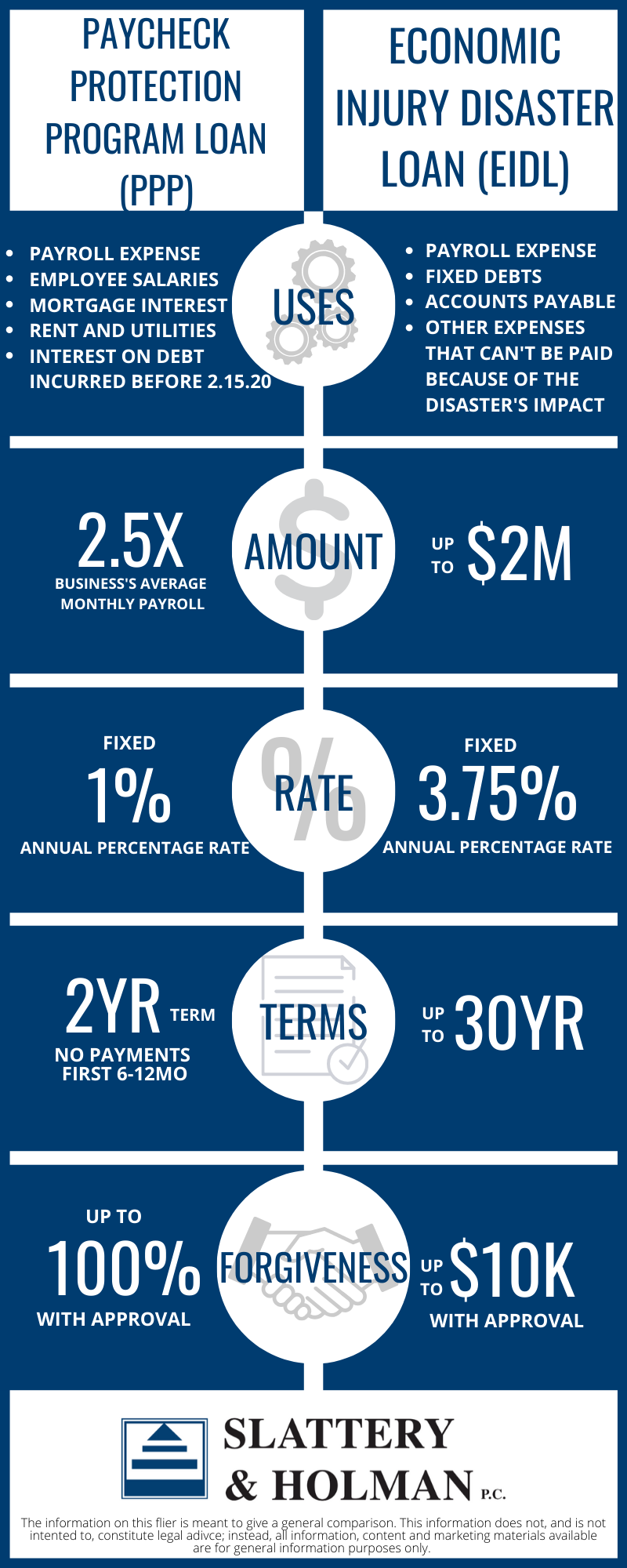Paycheck Protection Program
What is the Paycheck Protection Program?
The CARES Act designates $349 billion for general business loans to be distributed under section 7(a) of the Small Business Act during a designated “covered period,” February 15 through June 30, 2020. Borrowers can qualify for up to $10 million in 100% federal government guaranteed covered loans. Under the CARES act, the portion of these loans that is used for allowable purposes will be forgiven.
Who qualifies for the program?
Firstly, businesses and other entities seeking PPP loans must have been in operation on February 15, 2020. Eligible recipients include:
- Small businesses (fewer than 500 employees)
- Sole proprietors, independent contractors, and eligible self-employed individuals (see below for more details)
- IRC Section 501(c)(3) nonprofits
- IRC Section 501(c)(19) veterans’ organizations
- Tribal businesses under Section 31(b)(2)(C) of the Small Business Act (see below for more details)
For the purposes of the PPP, sole proprietors, independent contractors, and eligible self-employed individuals are those that are entitled to receive paid leave per the Emergency Paid Sick Leave Act. When applying, these individuals must submit documentation that establishes their eligibility (payroll tax filings, 1099s, and income/expense details for sole proprietorships). Tribal businesses that qualify are those with 500 or fewer employees (includes full-time, part-time, and other) or those that are the size standard established by the SBA for the industry in which they operate.
Eligible businesses can be precluded from receiving loans through the PPP by certain business affiliations. If the business is affiliated with a larger business (greater than 500 employees), they may be disqualified from participating in the PPP. An affiliation exists in two cases:
- One business controls another (or has the power to control it)
- A third party controls multiple businesses (or has the power to control them)
Additionally, the PPP expands eligibility to certain businesses with multiple locations, provided that each location has fewer than 500 employees. These eligible businesses have a North American Industry Classification System (NAICS) code that begins with 72 (accommodation and food services sector). The CARES Act waives affiliation rules for these businesses.
How much are the loans under the PPP?
The maximum loan amount is $10 million, though not every applicant is eligible for that amount. There are three methods by which an entity’s loan amount can be calculated:
- For entities in business from February 15, 2019 – June 30, 2019: Calculate your average total monthly payments for payroll during the period and multiply it by 2.5.
- For entities that were not in business from February 15, 2019 – June 30, 2019: Calculate your average total monthly payments for payroll between January 1, 2020 and February 29, 2020 and multiply it by 2.5.
- For entities that took out an Economic Injury Disaster Loan (EIDL) between February 15, 2020 and June 30, 2020: You can refinance your loan into a PPP loan. Add the outstanding loan amount to the payroll sum.
How can the loan money be used?
Allowable uses of the PPP loans include:
- Salaries, wages, commissions, or similar compensations (up to $100,000 per year per employee, prorated)
- Cash tips or equivalent
- Employee leave, including parental, family, medical, or sick (excluding family or sick leave under the Families First coronavirus Response Act)
- Allowances for dismissal or separation
- Group healthcare benefits, including insurance premiums, excluding >2% shareholders
- Retirement benefits
- State or local taxes on employee compensation (not including the employer’s share of FICA payroll taxes, railroad retirement act taxes, or other required U.S. income tax withholding)
- Continuation of group healthcare benefits during employee leave and insurance premiums
- Mortgage interest, rent, utility payments (including phone and internet), and any other debt obligations incurred prior to February 15, 2020
Additionally, sole proprietors and independent contractors may use the loan money to cover compensation and income of up to $100,000 per year (prorated).
What if I use the money for a non-allowable purpose?
Loan money used for any of the allowable purposes listed above will be forgiven; loan money used for non-allowable purposes must be repaid. Any balance remaining, after the amount used on allowable purposes is forgiven, will continue to be a fully guaranteed loan for up to ten years from the date of application.
What fees are associated with getting a PPP loan?
All service fees, prepayment fees, and borrower guarantees are waived for PPP loans.
What sort of collateral or personal guarantees are required?
Loans covered under the PPP require neither collateral nor personal guarantees, if the money is used for allowable purposes.
What is the interest rate on the loans?
The maximum interest rate is 1%.
What if I can obtain credit elsewhere?
While normally SBA loans only go to borrowers who cannot obtain credit elsewhere, for PPP loans, this requirement is waived.
How do I apply for the program?
The SBA and the Department of Treasury have approved thousands of institutions to be authorized lenders for the PPP. You can contact any local banking institution to find out if they are an approved lender, or use the Lender Match, an online tool from the SBA. Additionally, you can reach out to an SBA development center for local assistance in finding a lender.

